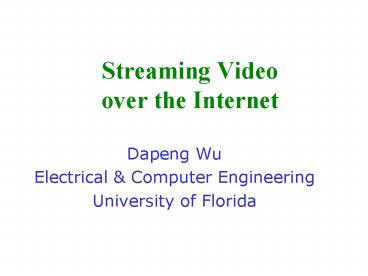Streaming Video over the Internet PowerPoint PPT Presentation
Title: Streaming Video over the Internet
1
Streaming Video over the Internet
- Dapeng Wu
- Electrical Computer Engineering
- University of Florida
2
What is Streaming Video?
Receiver 1
- Download mode no delay bound
- Streaming mode delay bound
Access SW
Domain B
Domain A
Data path
Domain C
Access SW
Internet
Source
Receiver 2
RealPlayer
cnn.com
3
Outline
- Challenges for quality video transport
- An architecture for video streaming
- Video compression
- Application-layer QoS control
- Continuous media distribution services
- Streaming server
- Media synchronization mechanisms
- Protocols for streaming media
- Summary
4
Time-varying Available Bandwidth
Receiver
No bandwidth reservation
Access SW
Domain B
Rgt56 kb/s
Domain A
Data path
Rlt56 kb/s
56 kb/s
RealPlayer
Source
cnn.com
5
Time-varying Delay
Receiver
Access SW
RealPlayer
Domain B
Domain A
Data path
Delayed packets regarded as lost
56 kb/s
Source
cnn.com
6
Effect of Packet Loss
Receiver
No packet loss
Access SW
Domain B
Domain A
Data path
Loss of packets No retransmission
Source
7
Unicast vs. Multicast
Multicast
Unicast
Pros and cons?
8
Heterogeneity For Multicast
- Network heterogeneity
- Receiver heterogeneity
Receiver 2
256 kb/s
Access SW
What Quality?
Domain B
Domain A
Domain C
Internet
Gateway
Ethernet
Telephone networks
1 Mb/s
Source
Receiver 1
Receiver 3
64 kb/s
What Quality?
9
Outline
- Challenges for quality video transport
- An architecture for video streaming
- Video compression
- Application-layer QoS control
- Continuous media distribution services
- Streaming server
- Media synchronization mechanisms
- Protocols for streaming media
- Summary
10
Architecture for Video Streaming
11
Video Compression
Layer 0
64 kb/s
Layer 1
256 kb/s
Layered Coder
Layer 2
1 Mb/s
Layered video encoding/decoding. D denotes the
decoder.
12
Application of Layered Video
Receiver 2
256 kb/s
IP multicast
Access SW
Domain B
Domain A
Domain C
Internet
Gateway
Ethernet
Telephone networks
1 Mb/s
Source
Receiver 1
Receiver 3
64 kb/s
13
Application-layer QoS Control
- Congestion control (using rate control)
- Source-based, requires
- rate-adaptive compression or
- rate shaping
- Receiver-based
- Hybrid
- Error control
- Forward error correction (FEC)
- Retransmission
- Error resilient compression
- Error concealment
14
Congestion Control
- Window-based vs. rate control (pros and
cons?)
Window-based control
Rate control
15
Source-based Rate Control
16
Video Multicast
- How to extend source-based rate control to
multicast? - Limitation of source-based rate control in
multicast - Trade-off between bandwidth efficiency and
service flexibility
17
Receiver-based Rate Control
IP multicast for layered video
Receiver 2
256 kb/s
Access SW
Domain B
Domain A
Domain C
Internet
Gateway
Ethernet
Telephone networks
1 Mb/s
Source
Receiver 1
Receiver 3
64 kb/s
18
Error Control
- FEC
- Channel coding
- Source coding-based FEC
- Joint source/channel coding
- Delay-constrained retransmission
- Error resilient compression
- Error concealment
19
Channel Coding
20
Delay-constrained Retransmission
21
Outline
- Challenges for quality video transport
- An architecture for video streaming
- Video compression
- Application-layer QoS control
- Continuous media distribution services
- Streaming server
- Media synchronization mechanisms
- Protocols for streaming media
- Summary
22
(No Transcript)
23
Continuous Media Distribution Services
- Content replication (caching mirroring)
- Network filtering/shaping/thinning
- Application-level multicast (overlay networks)
24
Caching
- What is caching?
- Why using caching? WWW means World Wide Wait?
- Pros and cons?
25
Outline
- Challenges for quality video transport
- An architecture for video streaming
- Video compression
- Application-layer QoS control
- Continuous media distribution services
- Streaming server
- Media synchronization mechanisms
- Protocols for streaming media
- Summary
26
Streaming Server
- Different from a web server
- Timing constraints
- Video-cassette-recorder (VCR) functions (e.g.,
fast forward/backward, random access, and
pause/resume). - Design of streaming servers
- Real-time operating system
- Special disk scheduling schemes
27
Media Synchronization
- Why media synchronization?
- Example lip-synchronization (video/audio)
28
Protocols for Streaming Video
- Network-layer protocol Internet Protocol (IP)
- Transport protocol
- Lower layer UDP TCP
- Upper layer Real-time Transport Protocol (RTP)
Real-Time Control Protocol (RTCP) - Session control protocol
- Real-Time Streaming Protocol (RTSP) RealPlayer
- Session Initiation Protocol (SIP) Microsoft
Windows MediaPlayer Internet telephony
29
Protocol Stacks
30
Summary
- Challenges for quality video transport
- Time-varying available bandwidth
- Time-varying delay
- Packet loss
- An architecture for video streaming
- Video compression
- Application-layer QoS control
- Continuous media distribution services
- Streaming server
- Media synchronization mechanisms
- Protocols for streaming media

